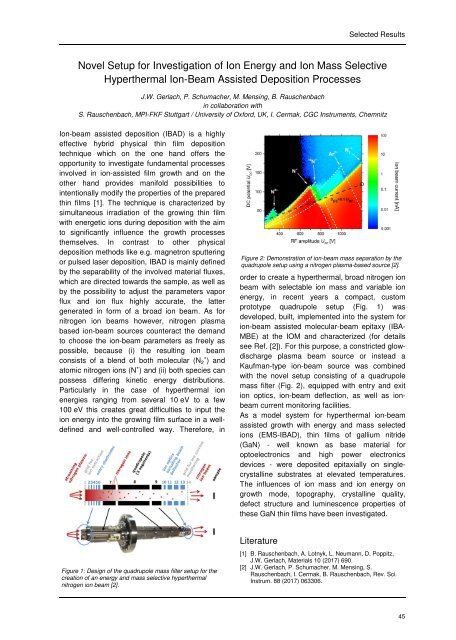Biennial Report 2016/2017
You also want an ePaper? Increase the reach of your titles
YUMPU automatically turns print PDFs into web optimized ePapers that Google loves.
Selected Results<br />
Novel Setup for Investigation of Ion Energy and Ion Mass Selective<br />
Hyperthermal Ion-Beam Assisted Deposition Processes<br />
J.W. Gerlach, P. Schumacher, M. Mensing, B. Rauschenbach<br />
in collaboration with<br />
S. Rauschenbach, MPI-FKF Stuttgart / University of Oxford, UK, I. Cermak, CGC Instruments, Chemnitz<br />
Ion-beam assisted deposition (IBAD) is a highly<br />
effective hybrid physical thin film deposition<br />
technique which on the one hand offers the<br />
opportunity to investigate fundamental processes<br />
involved in ion-assisted film growth and on the<br />
other hand provides manifold possibilities to<br />
intentionally modify the properties of the prepared<br />
thin films [1]. The technique is characterized by<br />
simultaneous irradiation of the growing thin film<br />
with energetic ions during deposition with the aim<br />
to significantly influence the growth processes<br />
themselves. In contrast to other physical<br />
deposition methods like e.g. magnetron sputtering<br />
or pulsed laser deposition, IBAD is mainly defined<br />
by the separability of the involved material fluxes,<br />
which are directed towards the sample, as well as<br />
by the possibility to adjust the parameters vapor<br />
flux and ion flux highly accurate, the latter<br />
generated in form of a broad ion beam. As for<br />
nitrogen ion beams however, nitrogen plasma<br />
based ion-beam sources counteract the demand<br />
to choose the ion-beam parameters as freely as<br />
possible, because (i) the resulting ion beam<br />
consists of a blend of both molecular (N 2 + ) and<br />
atomic nitrogen ions (N + ) and (ii) both species can<br />
possess differing kinetic energy distributions.<br />
Particularly in the case of hyperthermal ion<br />
energies ranging from several 10 eV to a few<br />
100 eV this creates great difficulties to input the<br />
ion energy into the growing film surface in a welldefined<br />
and well-controlled way. Therefore, in<br />
Figure 2: Demonstration of ion-beam mass separation by the<br />
quadrupole setup using a nitrogen plasma-based source [2].<br />
order to create a hyperthermal, broad nitrogen ion<br />
beam with selectable ion mass and variable ion<br />
energy, in recent years a compact, custom<br />
prototype quadrupole setup (Fig. 1) was<br />
developed, built, implemented into the system for<br />
ion-beam assisted molecular-beam epitaxy (IBA-<br />
MBE) at the IOM and characterized (for details<br />
see Ref. [2]). For this purpose, a constricted glowdischarge<br />
plasma beam source or instead a<br />
Kaufman-type ion-beam source was combined<br />
with the novel setup consisting of a quadrupole<br />
mass filter (Fig. 2), equipped with entry and exit<br />
ion optics, ion-beam deflection, as well as ionbeam<br />
current monitoring facilities.<br />
As a model system for hyperthermal ion-beam<br />
assisted growth with energy and mass selected<br />
ions (EMS-IBAD), thin films of gallium nitride<br />
(GaN) - well known as base material for<br />
optoelectronics and high power electronics<br />
devices - were deposited epitaxially on singlecrystalline<br />
substrates at elevated temperatures.<br />
The influences of ion mass and ion energy on<br />
growth mode, topography, crystalline quality,<br />
defect structure and luminescence properties of<br />
these GaN thin films have been investigated.<br />
Figure 1: Design of the quadrupole mass filter setup for the<br />
creation of an energy and mass selective hyperthermal<br />
nitrogen ion beam [2].<br />
Literature<br />
[1] B. Rauschenbach, A. Lotnyk, L. Neumann, D. Poppitz,<br />
J.W. Gerlach, Materials 10 (<strong>2017</strong>) 690.<br />
[2] J.W. Gerlach, P. Schumacher, M. Mensing, S.<br />
Rauschenbach, I. Cermak, B. Rauschenbach, Rev. Sci.<br />
Instrum. 88 (<strong>2017</strong>) 063306.<br />
45


